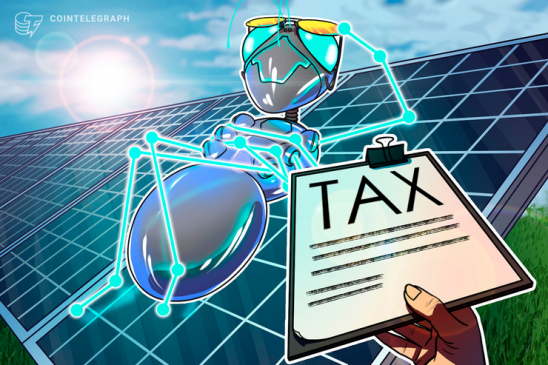Society is now witnessing the implementation of digital currencies, AI and blockchain technology worldwide. These new digital technologies, necessitate very high consumption of electric energy, currently produced with coal and fossil fuels with adverse environmental effects. A global shift towards green energy will require the removal of the technological/infrastructure, financial and regulatory/tax policy barriers. In a series of articles, we will evaluate the tax, digital technology and solar policies (including space power satellites) of the top CO2 emitting countries.
The United States is at the forefront of blockchain and artificial intelligence (AI) technology adoption — both the government and private industry. And Bitcoin’s volatility recovery is fueling this process.
According to reports, the United States government spending on blockchain is expected to Increase by 1,000% between 2017 and 2022, while U.S. investors are expected to increasingly invest in digital assets to add diversity to their investment portfolios and resume cryptocurrency mining as it once again becomes profitable.
Blockchain transformation
The announcement by Facebook — with 2.7 billion users — that it will be issuing a new cryptocurrency named Libra to compete with China’s blockchain-based mobile payment system — with 1.5 billion users — has put pressure on the largest U.S. financial institutions for a quick blockchain transformation. Already, JPMorgan Chase has announced that it will be issuing an utility settlement cryptocurrency (USC) coin called JPM Coin. BNY Mellon, Nasdaq and State Street, on the other hand, are backing the development of USCs denominated in five major fiat currencies: the U.S. dollar, the Canadian dollar, the British pound, the Japanese yen and the euro.
Blockchain applications not limited to fintech and are being adopted across various industries in the U.S. For example, the shipping-focused blockchain TradeLens, developed by IBM and Maersk, recruited two major marine cargo carriers to help usher in the digital transformation of the global supply chain. Separately, IBM piloted a blockchain and internet of things sensor solution to track sustainable groundwater usage. Pfizer Inc. and other leading American pharmaceutical companies joined a project to build a blockchain network for the health and pharmaceutical industries.
In the aerospace industry, blockchain technology is being implemented in myriad ways, including flight recorders, airspace management, cyber security, tracking parts during the manufacturing process and in establishing secure, efficient and prioritized data as well as command communication pathways among ground and space-based sources. In addition, U.S. energy companies Brooklyn Microgrid, Clearway Energy Group and Grid are developing applications for trading renewable energy credits on a blockchain.
These new digital technologies will replace many jobs and necessitate a very large consumption of electric energy that is currently produced with coal and fossil fuels — which has adverse environmental effects, according to the United Nations World Meteorological Organization. Cryptocurrency mining alone generates about 22 megatons of carbon dioxide emissions each year, based on a study by the Technical University of Munich and Massachusetts Institute of Technology.
A report issued by LUT University in Finland and the Energy Watch Group in Germany states that transitioning to green energy — 69% solar — can be accomplished globally in an economically competitive way in order to reduce greenhouse gas emissions in the energy system to zero by 2050. Among other important options, solar power satellite (SPS) systems remain one of the most promising but is currently a largely undeveloped option to accomplish this goal.
Solar power satellites
Paul Jaffe, an electronics engineer who has investigated SPS systems for the U.S. Naval Research Laboratory (NRL), explained that “anything we can do to wean away from coal and fossil fuels is a step in the right direction. Implementing SPS might result in a clean, constant, and globally distributable energy supply — unmatched by any earth-bound source.”
The SPS transmission idea — in which energy captured from the sun is transmitted via microwave beams to nearby planets from a space station — was first mentioned in a short story in 1941 titled “Reason” by Russian-born, U.S. science fiction writer Isaac Asimov.
In 1968, the concept for SPS technology emerged when aerospace engineer Peter Glaser published the first technical article, “Power from the Sun: Its Future,” in the journal Science, in which he described collecting solar power in outer space via solar cells on a satellite system at geosynchronous orbit, where sunlight is available almost continuously (more than 99.8% of the time each year), that would be capable of converting sunlight directly into electricity and distributing it to Earth via a wireless transmission system to a receiver.
There are two potentially viable options: laser and microwave beams. According to an NRL research report from 2009, SPS systems offer one of several possible solutions to the energy independence and dominance of our country and our military, but that there remain significant system risks in many areas. For example, safe power densities for wireless energy transmission generally restrict applications to large, relatively immobile receiver sites. Jaffe explained:
“While safety is a concern, wireless power transfer can be implemented to stay below existing safety limits. In general, microwave transmission requires larger diameter transmitters and receivers than laser.”
Unlike land-based solar power, which has been inefficient due to the atmospheric, day/night light interference, a SPS system could continuously harnesses the sun’s energy, working not only when there is daylight but also at night, during rain or snow and even on cloudy days — 24 hours a day, 365 days a year. For these reasons, the concept of SPS initially attracted a lot of attention during the 1970s, when NASA technical reports indicated that the SPS concept was technically feasible but economically unrealistic — and thus, the U.S. government and its agencies cut funding for solar cell research during the 1980s. According to Jaffe:
“For space solar to work, it will almost certainly need to offer some compelling advantage in a given application before it can compete on cost. There are several segments involved: launch, manufacture of the space and ground portions, and the industries associated with each. The logistics will be challenging.”
The International Academy of Astronautics completed the first international assessment of SPS during 2008-2011, involving diverse subject matter experts from some 10 countries concluding that it is technically feasible and that it might be realized in as little as 10-15 years. “Space solar is an enabling technology that could leapfrog the electric-power transmission grid on Earth, and have a similar effect that previous satellites have had on communications,” Jaffe said, but it has yet to electrify U.S. terrestrial grids. Instead, ground-based solar energy has been making an important contribution of one-sixth to the U.S. energy mix.
The world’s largest renewable energy company, Nextera, forecasts solar energy costs at $30 to $40 per watt, post 2023. While, utility-scale solar farms in India already generate solar energy for $0.03-$0.04 a watt according to Greg Nemet, a professor at the University of Wisconsin-Madison’s La Follette School of Public Affairs, who has written a new book on global policy and market forces that combined to make solar electricity one of the cheapest forms of energy, said “It’s possible solar prices could have bottomed out a decade or two sooner had the U.S. not slashed funding in the 1980s” — or had the U.S. environmental tax policy been more favorable toward solar energy and SPS by including it in government incentive programs as opposed to heavily subsidizing fossil fuels since the enactment of the U.S. tax code in 1873.
U.S. environmental tax policy
Environmental tax is used as an economic instrument to address environmental problems by taxing activities that burden the environment (e.g., a direct carbon tax) or by providing incentives to reduce the environmental burden and preserve the environmentally friendly activities (e.g., tax credits, subsidies). It is used as part of a market-based climate policy that was pioneered in the U.S., which also includes cap-and-trade energy emission allowance trading programs that attempt to limit emissions by putting a cap on and price on them.
Environmental taxes are designed to internalize environmental costs and provide economic incentives for people and businesses to promote ecologically sustainable activities, to reduce carbon dioxide emissions, to promote green growth and to fight climate change via innovation. Some governments make use of them to integrate climate and environmental costs into prices to reduce excessive emissions while raising revenue to fund vital government services.
Carbon Tax: Under a carbon tax regime, the government sets a price that emitters must pay for each ton of greenhouse gas emissions they emit so that businesses and consumers will take necessary steps — such as switching fuels or adopting new technologies — to reduce their emissions in order to avoid paying the tax, as taxes have distortionary effects that influence free-market decisions. Carbon taxes are favored because administratively assigning a fee to CO2 pollution is relatively simple compared to addressing climate change by setting, monitoring and enforcing caps on greenhouse gas emissions as well as regulating emissions of the energy-generation sector. Four subsets of environmental taxes are distinguished: energy taxes, transport taxes, pollution taxes and resource taxes.
The U.S. is the world’s number two in CO2 emission, owing 84% of its greenhouse gas emissions to fossil fuels. Currently, it does not impose a federal carbon tax. However, the congress in a bi-partisan effort is aiming to introduce a carbon tax in the US. Because, according to the Organization for Economic Cooperation and Development (OECD), greater reliance on environmental taxation is needed to strengthen global efforts to tackle the principal source of both greenhouse gas emissions and air pollution.
A carbon price/tax of between $50-$100 per ton will be needed to be implemented by signatories to deliver on Paris Agreement commitments by 2030 according to a report titled “High-Level Commission on Carbon Prices”, written by Nobel Laureate Economist Joseph Stiglitz and Nicholas Stern.
Tax Credits: Through tax credits, subsidies and other business incentives, governments can encourage companies to engage in behaviors and develop technologies that can reduce CO2 emissions. Just as tax credits for fossil fuel energy sources has enabled growth and development, renewable energy tax credits are incentives for the development and deployment of renewable energy technologies.
According to an International Monetary Fund (IMF) report, subsidies to hydrocarbon industry accounted for 85% of global subsidies of $4.7 trillion (6.3% of global GDP) in 2015, which were projected at $5.2 trillion (6.5% of GDP) in 2017, with the U.S. ranking number two in subsidies to the hydrocarbon industry, at $649 billion. In stark contrast, during 2016, subsidies for renewable energy totaled $6.7 billion — dropping 56% from 2013 levels, according to a report prepared by the U.S. Energy Information Administration. About 80% (or $5.6 billion) of the 2016 renewables subsidies came in the form of tax breaks, half of which went to biofuels like ethanol and biodiesel and the other half benefited wind and solar in the form of tax credits, which are set to expire at the end of 2021, though a permanent 10% investment tax credit for solar and geothermal installations will remain.
According to the IMF as well as the International Energy Agency, the elimination of fossil fuel subsidies worldwide would be one of the most effective ways of reducing greenhouse gases and battling global warming.
Conclusion
Increased digital technology adoption in the U.S. and around the world, will continue to push CO2 emission to its highest levels in history, if the electricity used to fuel it is largely produced with hydrocarbon energy. To cut down on CO2 emission during the height of the cryptocurrency bull market in 2017, the use of an SPS system was proposed to electrify crypto currency mining.
Transitioning to clean energy has become inevitable, a survival concern, so much so that investment advisors who manage nearly half the world’s invested capital, of more than $34 trillion in assets are urging the G20 for compliance with the Paris Agreement to save the global economy $160 trillion. Because the alternative, will result in damages of $54 trillion.
Nevertheless, switching to solar energy will likely necessitate — among other issues — adjustments to the U.S. environmental tax policy, which currently heavily favors fossil fuels.
Selva Ozelli, Esq., CPA is an international tax attorney and CPA who frequently writes about tax, legal and accounting issues for Tax Notes, Bloomberg BNA, other publications and the OECD.
The views, thoughts and opinions expressed here are the authors alone and do not necessarily reflect or represent the views and opinions of Cointelegraph.




